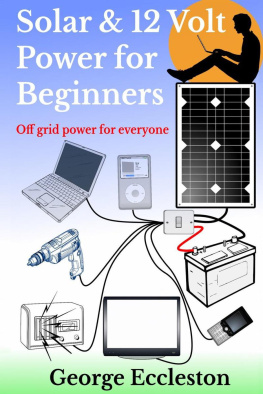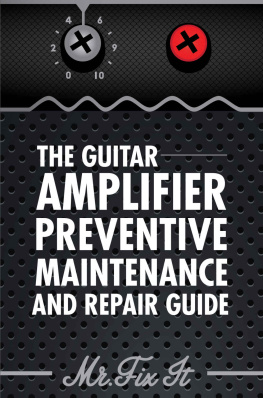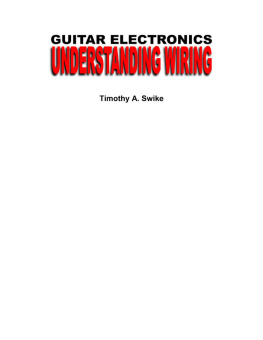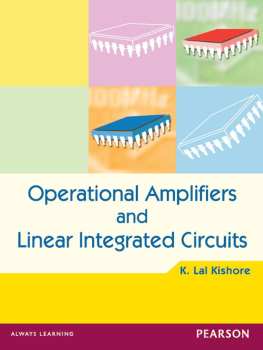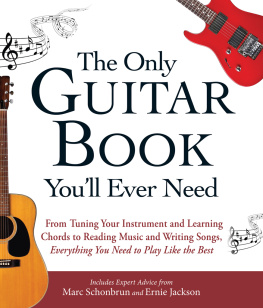Tim Swike - How to Make 9 Volt Portable Guitar Amplifiers
Here you can read online Tim Swike - How to Make 9 Volt Portable Guitar Amplifiers full text of the book (entire story) in english for free. Download pdf and epub, get meaning, cover and reviews about this ebook. year: 2010, publisher: createspace, genre: Home and family. Description of the work, (preface) as well as reviews are available. Best literature library LitArk.com created for fans of good reading and offers a wide selection of genres:
Romance novel
Science fiction
Adventure
Detective
Science
History
Home and family
Prose
Art
Politics
Computer
Non-fiction
Religion
Business
Children
Humor
Choose a favorite category and find really read worthwhile books. Enjoy immersion in the world of imagination, feel the emotions of the characters or learn something new for yourself, make an fascinating discovery.
- Book:How to Make 9 Volt Portable Guitar Amplifiers
- Author:
- Publisher:createspace
- Genre:
- Year:2010
- Rating:4 / 5
- Favourites:Add to favourites
- Your mark:
- 80
- 1
- 2
- 3
- 4
- 5
How to Make 9 Volt Portable Guitar Amplifiers: summary, description and annotation
We offer to read an annotation, description, summary or preface (depends on what the author of the book "How to Make 9 Volt Portable Guitar Amplifiers" wrote himself). If you haven't found the necessary information about the book — write in the comments, we will try to find it.
Tim Swike: author's other books
Who wrote How to Make 9 Volt Portable Guitar Amplifiers? Find out the surname, the name of the author of the book and a list of all author's works by series.
How to Make 9 Volt Portable Guitar Amplifiers — read online for free the complete book (whole text) full work
Below is the text of the book, divided by pages. System saving the place of the last page read, allows you to conveniently read the book "How to Make 9 Volt Portable Guitar Amplifiers" online for free, without having to search again every time where you left off. Put a bookmark, and you can go to the page where you finished reading at any time.
Font size:
Interval:
Bookmark:

Please Read This FIRST
Terms of Use
This Guitar Amplifier Electronics book is Copyright 2010. All rights reserved. No part of this book may be reproduced, stored in a retrieval system, or transmitted by any means; electronic, mechanical, photo copying, recording or otherwise, without written permission from the copyright holders. You do not have any right to distribute any part of this paperback book or electronic book in any way at all. Tim Swike, Mike Melvin, and indyebooks are the sole distributors. Violators will be prosecuted.
Adjusting, changing, soldering, adding, or removing the electronics in any device can be dangerous and can cause injuries. The authors of this book assume no responsibility for personal injury or property damage caused by the use of this guide, or products we use or sell, whether by accident, negligence, or otherwise. Please note that this book is intended for educational purposes only. Only qualified personnel should carry out any electrical work. USE AT YOUR OWN RISK.
Please send questions or comments to: indyebooks@aol.com
Several trademarks are used in this book for narrative purposes. Each trademark is the property of its respective owners.
COPYRIGHT 2010
ISBN: 1453728139
EAN-13: 9781453728130
This book is dedicated to my wonderful da ughter, Madeline Grace. She reminds me every day how beautiful life is.
Table of Contents
Introduction
Tools and Parts You Should Have 5
Tools and Parts You Need to Get 20
Building a Basic Amp lifier 85
Downloading the Color Ebook on 132
Y our Computer or Smart Phone
Checking the Website for Updates 133
Introduction
Right now y ou might be thinking to yourself There is no way I can build a portable amplifier all by myself. And definitely not one that sounds good. And even if I could, it probably would cost a fortune. Boutique stuff is expensive!
Now that might have been true in the past, but nowadays parts are easy to find, either online or at the local Radio Shack. You can even find new parts and used parts on auction sites like Ebay.com or Ioffer.com. And best of all, the components are pretty cheap. So not only can you make an amp that sounds great miced in the studio, but you can make an amp that is easy on your pocketbook. Best of all, you will be able to fine tune this amp to perfect your very own sweet sound. Sound good? Ok, now lets get started and discuss just what a 9 volt amp consists of.
In a nutshell , the portable amplifier is basically some type of box (wood, plastic, metal, paper, etc) that contains a breadboard, or grid style PC board, an 8 Ohm speaker, an LED light, a potentiometer, a mini toggle switch, some wires, a 9 volt battery, and an LM386 audio amplifier chip. Thats all there is to it. You can find most of these parts and info at your local hardware store, or online at Small Bear Electronics or Radio Shack. Check out the links below.
http://www.smallbearelec.com
http://www.radioshack.com
http://www.ebay.com
Tools and Parts You Should Already Have
Lets take a look at some of the tools and parts that you will need to build your own amp. I am going to start by discussing some of the items you should already have in your shop. If you dont, then you really should go out and get these items before doing any electrical work on guitars or amplifiers. These tools will come in handy for all of your electrical projects.
Soldering Iron
A soldering iron is essential for t his and any audio application. The liquid solder you buy in the tube just wont cut it, and it will ruin your sound. Below and on the next page are two common types of soldering irons that you can use for your guitar projects. The one directly below is a 30 Watt iron that has a pencil tip, which is perfect for working on small parts in tight areas. It will remain hot until it is unplugged, so it is recommended that you get a holder for it so you dont catch anything on fire. Often, the holders come with a sponge used for cleaning the tip in between solderings. Xytronic and Weller are my two favorite brands of soldering irons. You can find them online at smallbearelec.com.
smallbearelec.com part number: 2900

The picture below is a gun style soldering iron from Weller. When you pull the trigger, you will get up to 350 Watts of power (700 degrees). When you release the trigger, it quickly cools down. The gun soldering irons have a larger tip, so they work best when heating large amounts of solder for applications where solder joints and wiring is larger and there is sufficient space to work with the gun style soldering iron.

If you dont have a wet sponge or solder station, you can always use wet paper towel to clean off your soldering iron tip in between soldering applications.

60/40 Rosin Core Solder
You will need 60/40 rosin core solder for your guitar wiring projects. Every hardware store or Radio Shack should have rosin core solder in stock. Below is the.032 diameter solder sold in a plastic tube or on a roll.
smallbearelec.com part number: 290


Desolder Braid
A d esolder braid, or wick, when heated absorbs old solder left on your switches and potentiometers. So if you reuse electronics parts
often like I do, this stuff will keep your work neat and clean. Once a portion of the braid has been used to absorb solder, then that part of the braid is used up, and should be cut off and thrown away when its cool. Desolder braid can easily be found online.
smallbearelec.com part number: 290

22 AWG Wire (American Wire Gauge, size 22)
This is the wire that you will use to connect all of the circuitry of the amplifier. The wire below is from the same manufacturer that supplied wire to Fender. It has a double cloth jacket, waxed cotton outer braid, and a celanese inner braid. I love this stuff. It is stiff and bendable; making it a dream to use. It comes in several different colors like red, vintage white, and black, so you can keep your grounds all black and your hots all white or red. No need to strip your wires anymore, just pull back on the cloth to expose the bare wire. And when you are done soldering, just push the cloth back over the wire. You can find it online at:
http://stores.ebay.com/Classic-Clones-Amplification

Multimeter
Multimeters can be used t o check the DC resistance of pickups, potentiometers, leads, and speakers. You have probably used a multimeter to check how "hot" a pickup is, by connecting each multimeter lead to the hot and ground pickup wires, and then took a reading in Ohms ( ) . The next page will describe this in detail, in case you forgot. You can purchase a basic meter like the one below for under $25 at: http://www.electricsuppliesonline.com/spinhdtevapa.html
Next pageFont size:
Interval:
Bookmark:
Similar books «How to Make 9 Volt Portable Guitar Amplifiers»
Look at similar books to How to Make 9 Volt Portable Guitar Amplifiers. We have selected literature similar in name and meaning in the hope of providing readers with more options to find new, interesting, not yet read works.
Discussion, reviews of the book How to Make 9 Volt Portable Guitar Amplifiers and just readers' own opinions. Leave your comments, write what you think about the work, its meaning or the main characters. Specify what exactly you liked and what you didn't like, and why you think so.




